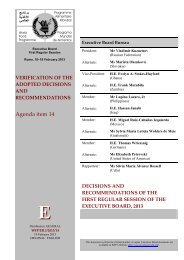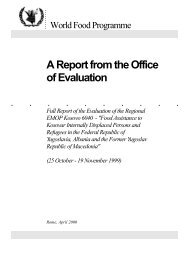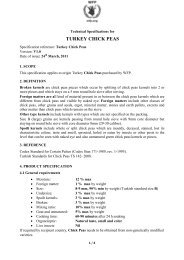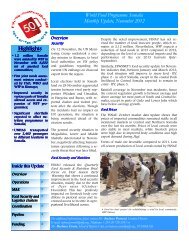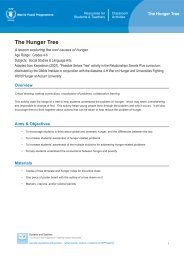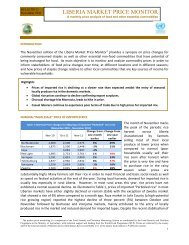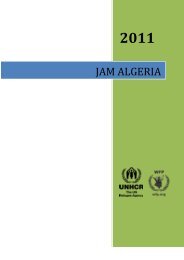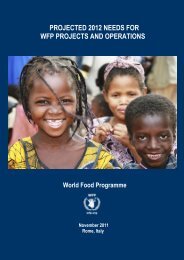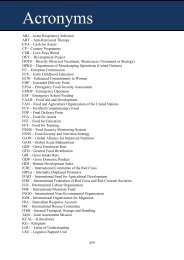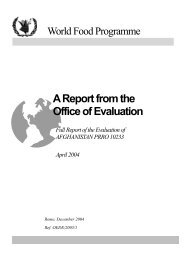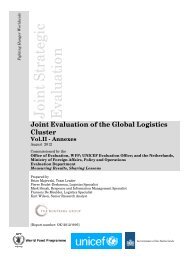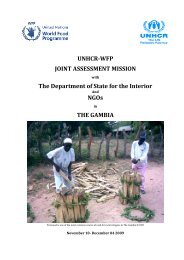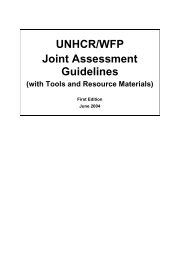The Potential for Scale and Sustainability in Weather Index Insurance
The Potential for Scale and Sustainability in Weather Index Insurance
The Potential for Scale and Sustainability in Weather Index Insurance
You also want an ePaper? Increase the reach of your titles
YUMPU automatically turns print PDFs into web optimized ePapers that Google loves.
16<br />
CHAPTER 1<br />
RISK IN AGRICULTURE<br />
Traditional risk-management arrangements frequently fail to provide an adequate<br />
safety net <strong>for</strong> the poor, especially aga<strong>in</strong>st high-severity, low-frequency risks. Own<strong>in</strong>g<br />
few assets, poor people have few options <strong>for</strong> cop<strong>in</strong>g with significant losses. <strong>The</strong>y are<br />
often <strong>for</strong>ced to sell important assets used <strong>for</strong> daily survival <strong>and</strong> <strong>in</strong>come (e.g. livestock),<br />
or to use sav<strong>in</strong>gs, which further adds to the long-term impact of natural hazards.<br />
Follow<strong>in</strong>g local production shocks, they are also more exposed to food price <strong>in</strong>creases<br />
<strong>and</strong> to any contraction <strong>in</strong> local employment opportunities <strong>and</strong> wages. <strong>The</strong>re is a<br />
grow<strong>in</strong>g literature show<strong>in</strong>g that repeated asset losses <strong>and</strong> <strong>in</strong>come shocks can conspire<br />
to keep poor households trapped <strong>in</strong> poverty (Barnett, Barrett <strong>and</strong> Skees 2008).<br />
Traditional risk-management methods are least effective at h<strong>and</strong>l<strong>in</strong>g lowfrequency,<br />
highly covariate risks that affect many people simultaneously (Sarris <strong>and</strong><br />
Christiansen 2007). <strong>The</strong>se events can overstretch the capacity of k<strong>in</strong> support networks<br />
<strong>and</strong> other community cop<strong>in</strong>g measures. <strong>The</strong>y may also <strong>in</strong>volve loss or damage of<br />
assets, mak<strong>in</strong>g recovery more uncerta<strong>in</strong> <strong>and</strong> slower. Many vulnerable people can slip<br />
<strong>in</strong>to poverty <strong>and</strong> become trapped. <strong>The</strong>se failures are all the greater when major lifethreaten<strong>in</strong>g<br />
catastrophes occur.<br />
As a covariate risk, drought shows some of the most dramatic evidence of the<br />
failure of traditional cop<strong>in</strong>g strategies. Detailed studies of the impact of severe<br />
droughts <strong>in</strong> Ethiopia (Webb <strong>and</strong> von Braun 1994), eastern India (P<strong>and</strong>ey, Bh<strong>and</strong>ari<br />
<strong>and</strong> Hardy 2007) <strong>and</strong> southern India (Hazell <strong>and</strong> Ramasamy 1991) all show that, <strong>in</strong><br />
percentage terms, <strong>in</strong>come losses can far exceed <strong>in</strong>itial production losses, because after<br />
the <strong>in</strong>itial shock, there is an associated collapse <strong>in</strong> local agricultural employment <strong>and</strong><br />
wages, non-farm <strong>in</strong>come <strong>and</strong> asset prices. Broader evidence of the impact of weather<br />
shocks confirms not only the significant short-term hardships that result, but also<br />
how temporary health <strong>and</strong> nutrition problems <strong>and</strong> the loss of productive assets such<br />
as livestock can underm<strong>in</strong>e long-term earn<strong>in</strong>g capacity (Fuente <strong>and</strong> Dercon 2008;<br />
López-Calva <strong>and</strong> Juárez 2008; <strong>and</strong> Grosh et al. 2008).<br />
In many areas, risk management is further underm<strong>in</strong>ed by grow<strong>in</strong>g population<br />
pressures on natural resources, lead<strong>in</strong>g to greater vulnerability when risk events occur.<br />
What was once a manageable shock can now be a catastrophe. Flood<strong>in</strong>g, <strong>for</strong> example,<br />
can have a more severe impact on livelihoods as population pressures push<br />
communities onto the more arable l<strong>and</strong> near waterways, which is also more<br />
susceptible to flood<strong>in</strong>g. Smallholders <strong>in</strong> develop<strong>in</strong>g countries are extremely<br />
vulnerable to such natural disasters, as nearly 75 per cent of the 1.3 billion people<br />
liv<strong>in</strong>g on less than a dollar a day depend on agricultural activities (World Bank 2007).<br />
Many live on ecologically fragile l<strong>and</strong> <strong>and</strong> depend on agriculture, livestock<br />
production, fisheries <strong>and</strong> <strong>for</strong>estry. Climate change is also <strong>in</strong>creas<strong>in</strong>g the frequency <strong>and</strong><br />
severity of many weather-related risks, further underm<strong>in</strong><strong>in</strong>g the effectiveness of<br />
traditional risk-management methods.



